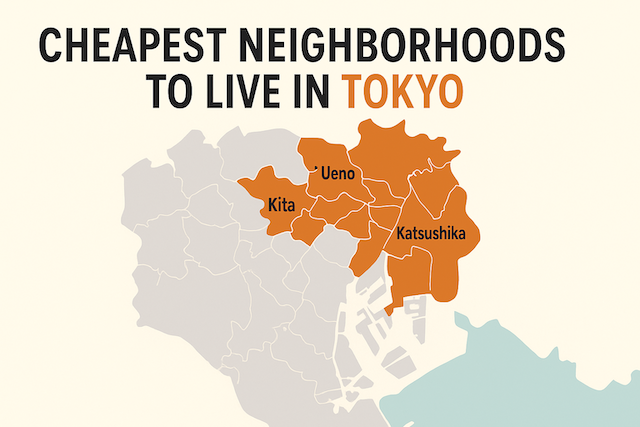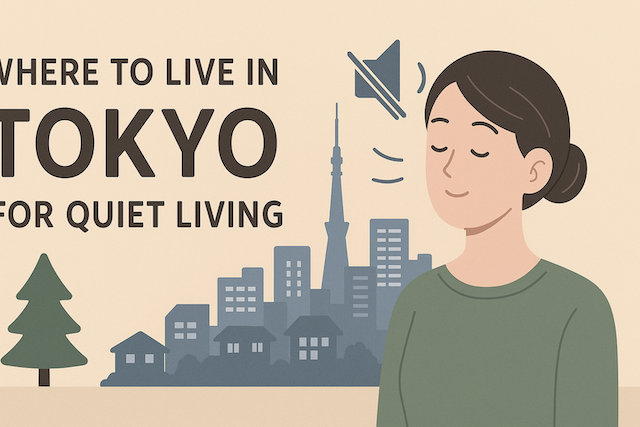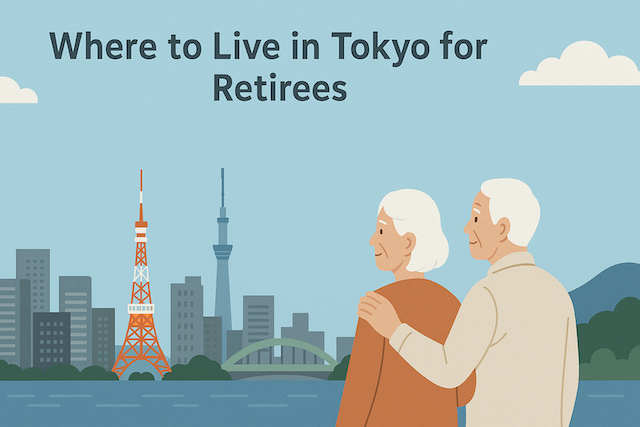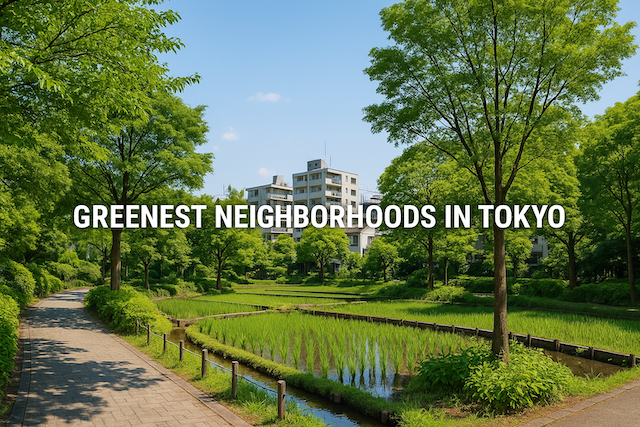Cheapest Neighborhoods to Live in Tokyo
Living in Tokyo is a dream for many, but it’s no secret that the cost of living can be high — especially when it comes to rent. However, not all areas of Tokyo are expensive. There are still several neighborhoods that offer affordable rent, good access to central areas, and a comfortable lifestyle for students, workers, and budget-conscious residents. In this guide, we’ll explore the cheapest neighborhoods to live in Tokyo, discuss their average rental prices, accessibility, and the overall lifestyle you can expect.
Why Consider Budget-Friendly Areas in Tokyo?
Tokyo’s high living costs often discourage people from moving here. Yet, choosing an affordable neighborhood doesn’t mean sacrificing quality of life. Many lesser-known districts offer:
-
Convenient train access to central Tokyo
-
Lower rent and living expenses
-
Local markets and restaurants with affordable prices
-
A quieter, more community-oriented atmosphere
These areas are ideal for students, freelancers, and families who want to enjoy Tokyo life without breaking the bank.
1. Adachi Ward (足立区)
Best for: Affordable rent and a relaxed local atmosphere.
Adachi Ward is one of the most budget-friendly areas in Tokyo. Located in the northern part of the city, it has a reputation for being inexpensive while still offering convenient train connections to central areas like Ueno, Akihabara, and Tokyo Station.
Average rent:
-
Studio (1K): ¥55,000–¥70,000
-
1LDK: ¥75,000–¥100,000
Transportation:
Key stations include Kita-Senju, Ayase, and Nishiarai — all offering good access via the JR Joban Line, Tokyo Metro Chiyoda Line, and Tobu Skytree Line.
Lifestyle:
Adachi offers large parks like Toneri Park, budget supermarkets, and local izakayas. Kita-Senju has developed into a mini downtown area with shopping centers and dining options, making it great for young residents.
2. Katsushika Ward (葛飾区)
Best for: Traditional Tokyo feel and low living costs.
Katsushika is famous for its old-town charm, peaceful streets, and affordable apartments. It’s located in the eastern part of Tokyo, bordering Chiba Prefecture.
Average rent:
-
Studio (1K): ¥50,000–¥65,000
-
1LDK: ¥70,000–¥95,000
Transportation:
Major stations include Kameari, Aoto, and Shinkoiwa. The JR Joban Line and Keisei Main Line make commuting to Ueno, Nippori, and central Tokyo straightforward.
Lifestyle:
If you like the atmosphere of traditional Japanese neighborhoods with local shops, small shrines, and riverside walking paths, Katsushika is perfect. It’s also home to the famous manga character Tora-san from Otoko wa Tsurai yo.
3. Edogawa Ward (江戸川区)
Best for: Families and riverside living.
Edogawa Ward lies on Tokyo’s eastern edge and is known for being family-friendly and green. While it’s slightly far from Shinjuku or Shibuya, commuting is manageable and rent is low.
Average rent:
-
Studio (1K): ¥55,000–¥70,000
-
1LDK: ¥80,000–¥100,000
Transportation:
Accessible via the Tozai Line, Sobu Line, and Toei Shinjuku Line. Popular stations include Kasai, Nishi-Kasai, and Koiwa.
Lifestyle:
You’ll find many parks, affordable schools, and international communities — particularly around Nishi-Kasai, which is sometimes called “Little India” for its large South Asian population. The nearby Edogawa River also offers relaxing outdoor areas.
4. Nerima Ward (練馬区)
Best for: Students and commuters seeking balance between cost and comfort.
Nerima is located in the northwest part of Tokyo and offers both affordability and convenience. It’s quieter than central areas but still well connected.
Average rent:
-
Studio (1K): ¥60,000–¥75,000
-
1LDK: ¥85,000–¥110,000
Transportation:
The Seibu Ikebukuro Line and Toei Oedo Line provide quick access to Ikebukuro, Shinjuku, and Roppongi.
Lifestyle:
Nerima is ideal for students attending universities in west Tokyo. It’s residential, with lots of local shops, restaurants, and cinemas. The area also has Nerima Art Museum and several parks, making it a relaxing yet convenient place to live.
5. Arakawa Ward (荒川区)
Best for: Access to central Tokyo at a low price.
Arakawa is located just north of Ueno and offers quick commutes to downtown Tokyo while keeping rent affordable.
Average rent:
-
Studio (1K): ¥65,000–¥80,000
-
1LDK: ¥90,000–¥120,000
Transportation:
Stations like Nippori, Minami-Senju, and Machiya are well-connected via JR Yamanote Line, Keisei Line, and Chiyoda Line.
Lifestyle:
Arakawa has a mix of old and new Tokyo. You’ll find traditional bathhouses, affordable eateries, and small community markets alongside modern apartments. It’s one of the few areas inside the Yamanote Line circle that remains relatively cheap.
6. Ota Ward (大田区)
Best for: Budget-friendly access to Haneda Airport.
Ota Ward is located in southern Tokyo and offers many affordable neighborhoods, particularly around Kamata and Omori.
Average rent:
-
Studio (1K): ¥65,000–¥85,000
-
1LDK: ¥90,000–¥115,000
Transportation:
The Keikyu Line and JR Keihin-Tohoku Line connect Ota to Shinagawa and Yokohama quickly. Haneda Airport is nearby, making it ideal for travelers or airline staff.
Lifestyle:
Kamata is known for its hot springs, shopping arcades, and local restaurants. Although Ota is large, it retains a relaxed suburban feel, with good access to both Tokyo and Kanagawa.
7. Itabashi Ward (板橋区)
Best for: Commuters to Ikebukuro and students.
Itabashi sits on Tokyo’s northwest border and is one of the city’s most underrated budget areas. It’s extremely convenient for those working or studying near Ikebukuro or Shinjuku.
Average rent:
-
Studio (1K): ¥60,000–¥75,000
-
1LDK: ¥85,000–¥110,000
Transportation:
Served by the JR Saikyo Line, Toei Mita Line, and Tobu Tojo Line. You can reach Ikebukuro in less than 10 minutes.
Lifestyle:
Itabashi combines low rent with urban convenience. There are many local izakayas, grocery stores, and quiet residential streets. Compared to neighboring Toshima, it’s much more affordable.
8. Suginami Ward (杉並区)
Best for: Artists, students, and young professionals.
While Suginami includes trendy areas like Koenji and Ogikubo, it’s still one of the cheaper options within the 23 wards. You’ll find a bohemian culture, affordable apartments, and vibrant nightlife.
Average rent:
-
Studio (1K): ¥65,000–¥85,000
-
1LDK: ¥90,000–¥120,000
Transportation:
Served by the JR Chuo Line and Marunouchi Line, connecting easily to Shinjuku and Tokyo Station.
Lifestyle:
Koenji is known for vintage shops, music bars, and festivals. Ogikubo is quieter but offers excellent ramen restaurants. Suginami is a great compromise between affordability and a fun, creative environment.
9. Hachioji City (八王子市)
Best for: Students and long-term residents seeking very low rent.
Located in western Tokyo, Hachioji is technically outside the 23 wards, but still within Tokyo Metropolis. It’s popular among university students and families looking for affordable housing.
Average rent:
-
Studio (1K): ¥40,000–¥55,000
-
1LDK: ¥60,000–¥80,000
Transportation:
JR Chuo Line provides access to Shinjuku in around 45–50 minutes.
Lifestyle:
Hachioji offers a suburban lifestyle with large apartments, parks, and shopping centers. It’s peaceful and significantly cheaper than inner Tokyo. Ideal for those who don’t mind a longer commute.
10. Machida City (町田市)
Best for: Balance of city and suburban living.
Machida is another area outside central Tokyo that offers excellent value for money. It’s often considered the “gateway” between Tokyo and Kanagawa Prefecture.
Average rent:
-
Studio (1K): ¥45,000–¥60,000
-
1LDK: ¥70,000–¥90,000
Transportation:
Odakyu Line and JR Yokohama Line connect Machida to Shinjuku and Yokohama in about 40 minutes.
Lifestyle:
Machida has large shopping complexes, restaurants, and entertainment options. Despite being on the outskirts, it feels like a mini city. It’s a favorite among students and families who want space and affordability.
Tips for Finding Cheap Apartments in Tokyo
-
Look outside the Yamanote Line:
Rent drops significantly beyond Tokyo’s central loop. -
Consider older buildings:
Apartments built 20–30 years ago are much cheaper and often well-maintained. -
Check proximity to stations:
Living 10–15 minutes away on foot can reduce rent by 10–20%. -
Use Japanese rental sites:
Websites like SUUMO, Homes, and CHINTAI often list better deals than English-language sites. -
Avoid peak moving seasons:
March and April are the busiest months; rent and key money may be higher.
Conclusion
Tokyo doesn’t have to be an expensive city to live in. Wards like Adachi, Katsushika, and Edogawa offer low-cost housing while maintaining great access to the city center. For those willing to live a bit farther, places like Hachioji and Machida provide even greater savings with more space and comfort.
Choosing the right budget neighborhood in Tokyo depends on your lifestyle — whether you prioritize commute time, quiet surroundings, or local culture. With some research and flexibility, you can enjoy the Tokyo lifestyle without spending a fortune.
FAQs
What are the cheapest areas to live in Tokyo right now?
Consistently budget-friendly choices include Adachi, Katsushika, Edogawa, Nerima, Arakawa, Ota, and Itabashi within the 23 wards, plus Hachioji and Machida on the metropolitan outskirts. These areas balance lower rents with reasonable access to central hubs.
How much is average rent in these budget neighborhoods?
Indicative monthly ranges (unfurnished, near but not directly at major stations):
- Studio/1K: ¥50,000–¥80,000 in the cheaper wards; ¥40,000–¥60,000 in Hachioji/Machida
- 1LDK: ¥70,000–¥120,000 depending on age, size, and proximity to the station
Newer buildings, renovated units, and locations within 5 minutes of a station price higher.
Why are these neighborhoods cheaper than central Tokyo?
Lower land costs, older housing stock, and slightly longer commutes reduce demand from premium renters. Many streets are residential, with smaller shopping streets instead of large commercial zones, which keeps prices down.
Are these areas safe for students and solo renters?
Tokyo generally has low crime. Still, compare micro-areas within each ward, check night lighting, foot traffic, and distance from the station. Read recent local reports, visit at night, and ask the agent for kōbans (police box) locations and neighborhood watch details. Safety varies by block, not just ward.
How long is the commute from these neighborhoods?
Typical train times to major hubs from representative stations:
- Kita-Senju (Adachi) to Ueno/Shinjuku: ~10–30 minutes
- Kameari/Aoto (Katsushika) to Ueno/Nippori: ~15–25 minutes
- Nishi-Kasai (Edogawa) to Otemachi: ~20–25 minutes
- Nerima to Ikebukuro/Shinjuku: ~10–25 minutes
- Hachioji or Machida to Shinjuku: ~40–55 minutes
Door-to-door time depends on transfers and walk times.
What hidden costs should I expect beyond rent?
Budget for initial fees (key money, deposit, agency fee, lock change), guarantor company fee, maintenance fee (kyoeki-hi), renters’ insurance, utilities, and internet setup. Initial move-in often equals 3–5 months of rent in total outlay, though “no key money” or “zero-zero” campaigns can reduce this.
How can I lower rent further without compromising too much?
- Choose buildings 20–30 years old with solid maintenance records
- Live 10–15 minutes on foot from the nearest station
- Target off-peak move-in months (May–December rather than March–April)
- Consider top-floor walk-ups without elevators or first-floor units
- Negotiate removable fees (e.g., cleaning or key money) rather than base rent
Is it harder for foreigners to rent in budget neighborhoods?
Some properties still require a Japanese guarantor or proof of stable income. Use agencies comfortable with foreign tenants, prepare documents (residence card, employment/acceptance letter, income proof), and consider guarantor companies. Sharehouses are often the most flexible entry point.
Sharehouse vs. private apartment: which is cheaper?
Sharehouses usually have lower move-in costs, furnished common areas, and short contracts—ideal for short stays or tight budgets. Private apartments offer privacy and stability but require higher upfront fees and longer commitments (often 2-year contracts).
What amenities can I expect at lower price points?
Expect compact layouts, unit bathrooms (prefab bath + toilet), basic kitchens (single or two-burner), and limited storage. Newer budget units may add separate bathrooms, bike parking, or delivery boxes. Elevators and auto-locks are less common in older, cheaper buildings.
How important is proximity to the station when budgeting?
Very. Being 10–15 minutes from a station can shave 10–20% off rent. However, factor in weather, late-night walks, and the quality of sidewalks and lighting. If you work late, prioritize safe, lit routes.
Can I find pet-friendly or family-sized units in cheaper areas?
Yes, especially in Edogawa, Ota, Nerima, Hachioji, and Machida where larger stock exists. Pet-friendly units are fewer and usually cost more (pet deposit or cleaning add-ons). Start early and filter for “pet ok” and “2LDK+.”
Which train lines offer the best value for money?
Lines with strong value-to-access ratios include the Tozai Line (Edogawa), Chiyoda/Joban corridors (Adachi/Katsushika), Seibu Ikebukuro and Tobu Tojo (Nerima/Itabashi), Keikyu and Keihin-Tohoku (Ota), and JR Chuo or Odakyu further out (Hachioji/Machida). Fewer transfers often justify slightly higher rent.
How do I verify listing quality and avoid bait-and-switch?
- Request the full building sheet (mansion meigi, year built, RC/SRC/wood)
- Confirm room number and exact floorplan before visiting
- Check mold, water pressure, and noise during the viewing
- Cross-reference the address and rent on multiple portals (SUUMO, Homes, CHINTAI)
When is the best time to move for cheaper deals?
Late spring through autumn (May–November) typically offers more negotiability than peak season in March–April. December–January can be mixed: fewer listings but motivated landlords.
Bottom line: how do I choose a cheap but livable neighborhood?
Start with a budget and commute threshold, shortlist 2–3 wards (or Hachioji/Machida if you can handle longer rides), and compare micro-areas on safety, lighting, noise, and grocery access. If you stay flexible on building age and walking distance to the station, you can keep costs low without sacrificing comfort.







